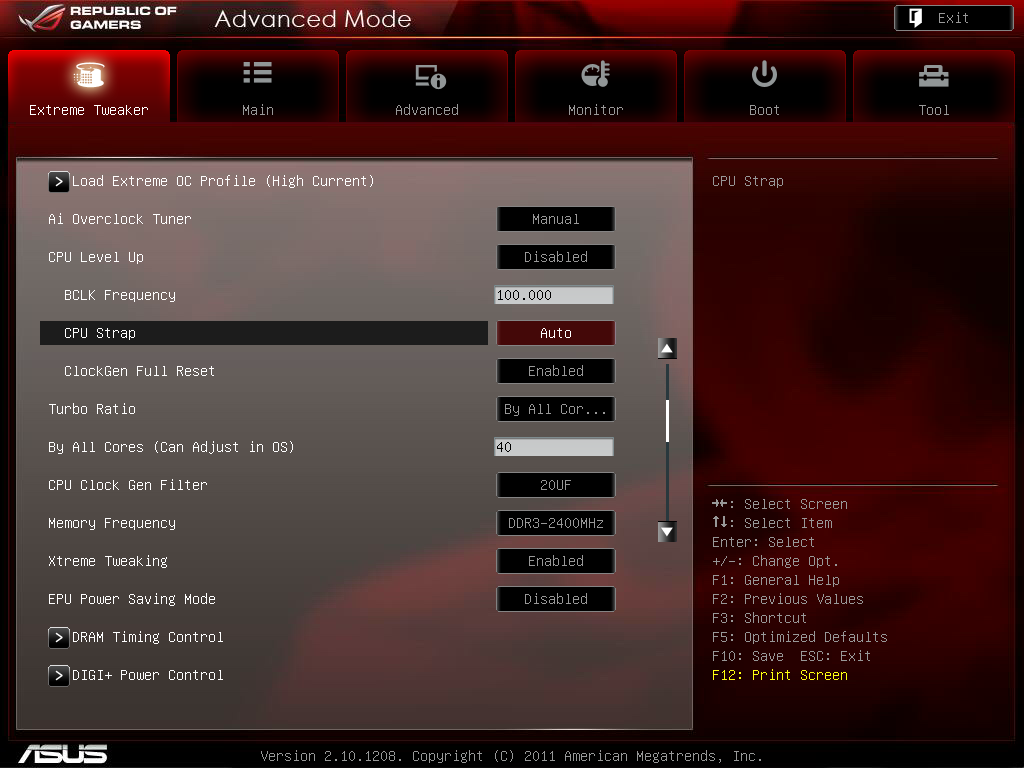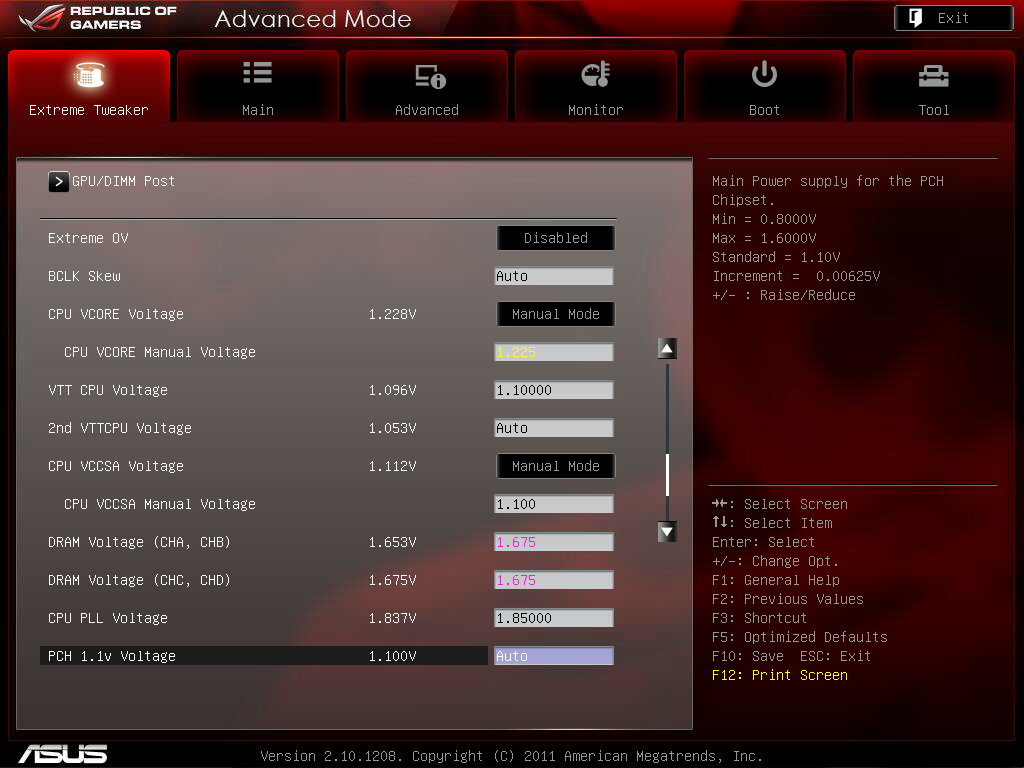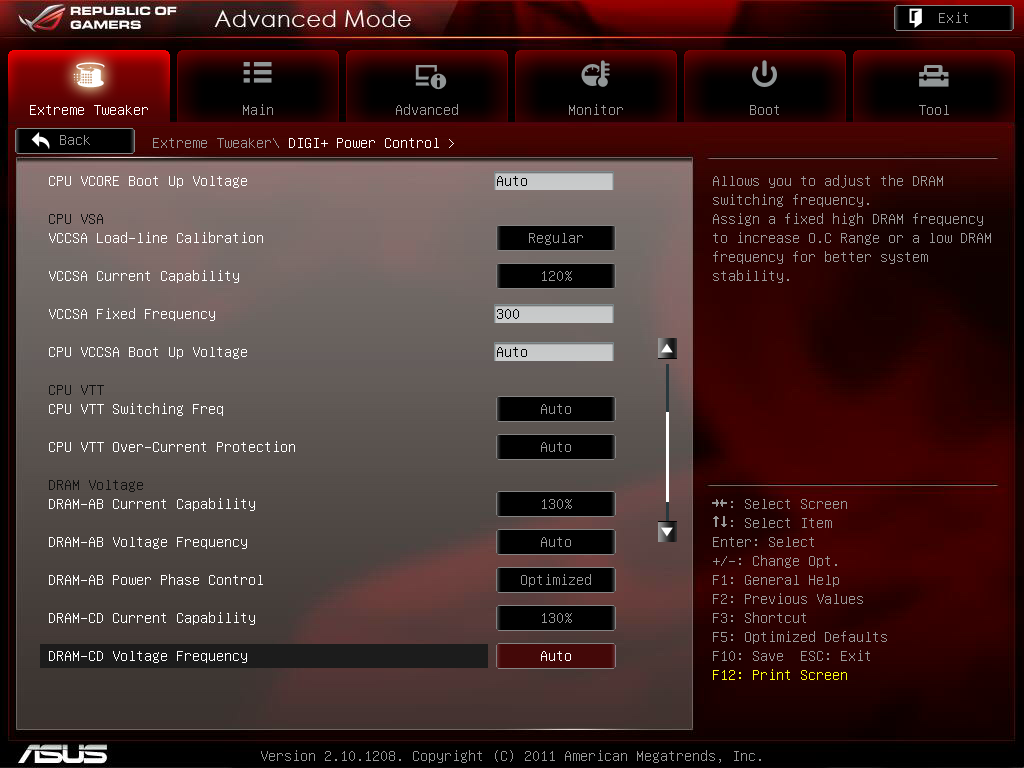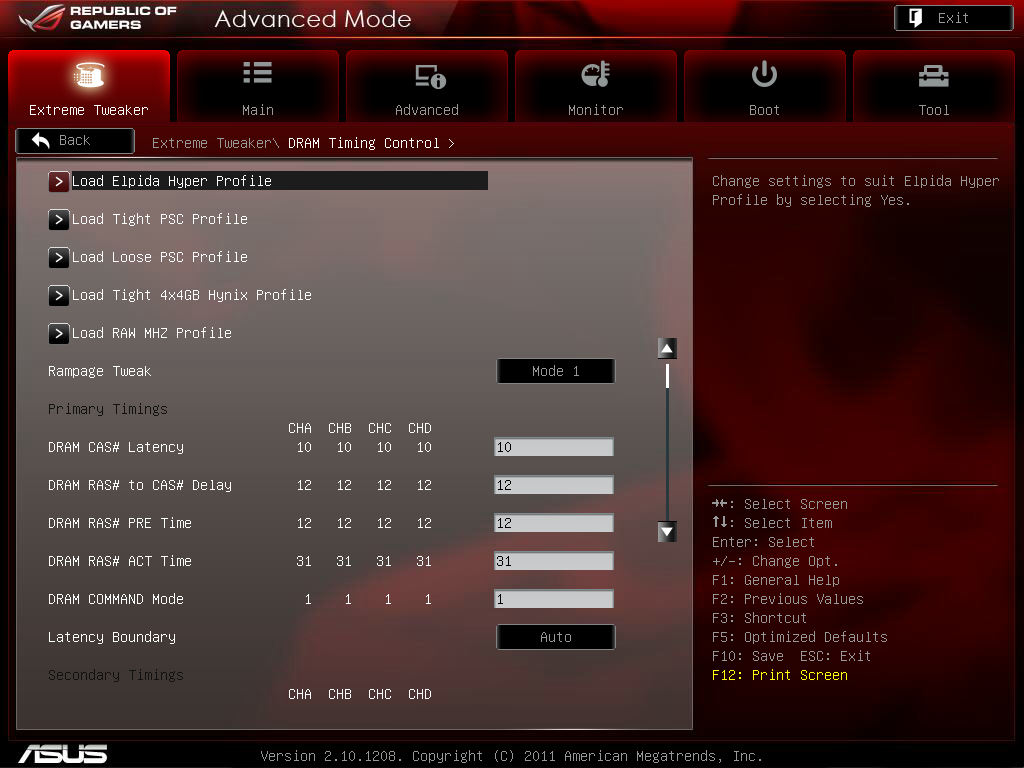You are using an out of date browser. It may not display this or other websites correctly.
You should upgrade or use an alternative browser.
You should upgrade or use an alternative browser.
X79 Overclocking Guide
- Thread starter 8 Pack
- Start date
More options
Thread starter's postsI am not interested in Prime man!! Its junk!!!
If its stable for your every day tasks then that's where you need to be.
Is it junk because you dont like stresstests in general or is it only Prime that you think is junk?
Though if you want your computer to do maths, it's sensible to make sure it can do maths without falling over. Prime tests some aspects of maths, linpack tests some other aspects of maths.
Passing prime and linpack doesn't mean your system is trustworthy. Failing them does mean it's now so close to the ragged edge that it makes mistakes doing simple arithmetic.
@8 Pack, I tend to realise my computer is no longer stable when my save games corrupt - have you seen anything similar?
Passing prime and linpack doesn't mean your system is trustworthy. Failing them does mean it's now so close to the ragged edge that it makes mistakes doing simple arithmetic.
@8 Pack, I tend to realise my computer is no longer stable when my save games corrupt - have you seen anything similar?
Ok so basically all my cores except for one is at 25-35c for idle, the other one is at 45c (It looks like it cant go lower than that and the usage is 0% aswell) But when i put load on the CPU the cores are all about the same, within 1-3c of eachother. I noticed my #0 core (The weird one) Is exactly the same as package temp. The only thing i have changed these last few hours was putting in extra 2 sticks of RAM for quad channel.
Once again, the load temps make sense, the core is as hot as any other. It just looks like it cant go below 45c on idle. Faulty sensor?
Anyone got any ideas? Should i worry?
Once again, the load temps make sense, the core is as hot as any other. It just looks like it cant go below 45c on idle. Faulty sensor?
Anyone got any ideas? Should i worry?
Associate
- Joined
- 14 Oct 2013
- Posts
- 9
Hey 8-Pack, thanks for the informative guide however I am still stuck on getting my 3930k stable at anything over 4.2ghz!
I've followed nearly every 3930k guide on the net and still can't figure out why I get BSOD's when upping the clocks (even with 1.4v+ on vcore).
My setup:
Gigabyte X79 UD5 on the f13w bios (latest)
32 GB corsair vengance RAM running @ stock 1600mhz (timings and voltages stock too).
Corsair H110 cooler in push/pull.
1000w PSU
My system is ROCK stable at 4.2ghz running 1.25 vcore, however no matter what I do with PLL voltages, vcore e.t.c I always get "Clock Watchdog Timeout" BSOD's when running at 4.4ghz+ (using multipliers, not strap adjustments) in a matter of seconds using prime95.
RAM always stays at 1600mhz.
I've even got a fan blowing on the VRM's to make sure that temps aren't a problem.
Could you please guide me as what I'm doing wrong?
Many thanks
I've followed nearly every 3930k guide on the net and still can't figure out why I get BSOD's when upping the clocks (even with 1.4v+ on vcore).
My setup:
Gigabyte X79 UD5 on the f13w bios (latest)
32 GB corsair vengance RAM running @ stock 1600mhz (timings and voltages stock too).
Corsair H110 cooler in push/pull.
1000w PSU
My system is ROCK stable at 4.2ghz running 1.25 vcore, however no matter what I do with PLL voltages, vcore e.t.c I always get "Clock Watchdog Timeout" BSOD's when running at 4.4ghz+ (using multipliers, not strap adjustments) in a matter of seconds using prime95.
RAM always stays at 1600mhz.
I've even got a fan blowing on the VRM's to make sure that temps aren't a problem.
Could you please guide me as what I'm doing wrong?
Many thanks
Mr 8-Pack would you be so kind to advise me on two questions
4390k on a Rampage Extreme, 16 gig Team Xtreem LV DDR3 2600 Quad-Channel water cooled idle temps 30 load 65.
First thing does the new 4403 have any cpu voltage problem, as i have had 2 4390 chips, one would not do over 4.4Ghz, and this one will only do 4.5Ghz at 1.55 volts. I have used the extreme water cooled bios template and have reduced the clock speeds to test, is there a way to lower the voltage somewhere else or have i just had two bad chips. Current running 4.4Ghz at 4.25v any less and Cinebench will crash.
Second, the Team Xtreem LV DDR3 2600 Quad-Channel memory will only show at 2400 with XMP is there any reason for this?
4390k on a Rampage Extreme, 16 gig Team Xtreem LV DDR3 2600 Quad-Channel water cooled idle temps 30 load 65.
First thing does the new 4403 have any cpu voltage problem, as i have had 2 4390 chips, one would not do over 4.4Ghz, and this one will only do 4.5Ghz at 1.55 volts. I have used the extreme water cooled bios template and have reduced the clock speeds to test, is there a way to lower the voltage somewhere else or have i just had two bad chips. Current running 4.4Ghz at 4.25v any less and Cinebench will crash.
Second, the Team Xtreem LV DDR3 2600 Quad-Channel memory will only show at 2400 with XMP is there any reason for this?
Last edited:
http://www.mediafire.com/download/5d4a9xn5f2v2isx/Rampage-IV-Extreme-ASUS-0024.rar
This is the latest Bios we all use for benching. Its the best one by far!!!
Concentrate on getting your CPU stable first then go for RAM. Team Group are set up that way on XMP not sure why but my kit works at 2600 no problem.
For 2600 RAM you will probably need VTT 1.3 and VCCSA 1.3 to start off. Also if I was you I would clock on 1.25 strap seems more stable to me.
This is the latest Bios we all use for benching. Its the best one by far!!!
Concentrate on getting your CPU stable first then go for RAM. Team Group are set up that way on XMP not sure why but my kit works at 2600 no problem.
For 2600 RAM you will probably need VTT 1.3 and VCCSA 1.3 to start off. Also if I was you I would clock on 1.25 strap seems more stable to me.
Associate
- Joined
- 31 Mar 2012
- Posts
- 1,737
http://www.mediafire.com/download/5d4a9xn5f2v2isx/Rampage-IV-Extreme-ASUS-0024.rar
This is the latest Bios we all use for benching. Its the best one by far!!!
Concentrate on getting your CPU stable first then go for RAM. Team Group are set up that way on XMP not sure why but my kit works at 2600 no problem.
For 2600 RAM you will probably need VTT 1.3 and VCCSA 1.3 to start off. Also if I was you I would clock on 1.25 strap seems more stable to me.
8Pack does this bios work on the R4F?
As asked for I have put together a brief but hopefully useful overclocking guide for X79 systems.
Firstly lets explain the straps used on X79. Basically there are two usable straps on X79 in the majority of cases. These are the 100 Strap and 125 Strap. If your CPU is on the 100 Strap then BLK directly correlates to bus speed. If your on the 125 strap then BLK will be 125 and bus speed will be 100 thus a divider of 1.25 is applied. So for any given BLK on the 125 strap you must divide the value by 1.25 to give your bus speed. e.g 131 BLK = 105 Bus speed. In all cases CPU frequency is given by multiplier x BLK.
Each strap comes with its own set of memory frequency's also. This must be figured into the equation with any overclocking. The 100 Bus has the usable 1333,1600, 1866,2133 and 2400 memory option while 125 has 1333, 1666,2000,2333mhz usable. So you have 2400mhz memory you can reach that speed using 100 BLK on the 100 strap or using 128.625 BLK on the 125 strap.
This gives flexibility to the end user in terms of CPU, Bus and Memory overclocking.
Lets look at some settings in Bios:
Multiplier set at 40, BLK 100 gives 4ghz. On the 125 strap 40 multi would give 5ghz.
The two interesting options on this first page are Clock Gen full reset and Clock Gen filter. Clock Gen full reset should be set to enable at all times so as when BLK is changed the memory is trained to the changed frequency. This helps a lot with stability. If your benching cold where your CPU has cold bug I would disable this option so the system does not retrain DRAM on blk changes and thus boots with cold bugged IMC.
Clock gen filter helps with high RAM speed clocking and should be set to 10 uf or 20uf for speeds around 2000 - 2400mhz+. This helps with stability as it filters the signal into the RAM when at high frequency. It should be at enable for lower speeds and disable if you mange to get a CPU which boots on the 166 strap.
Xtreme Tweaking gives a touch more DRAM performance so I leave it enabled. I have never noticed a negative impact on stability either with it on.
Further Down the Xtreme Tweaker we see the options for setting voltages:
Always leave Xtreme OV as disabled as even on the cold it need not be switched on and voltage selection is plentiful. Its a good safety measure too for not instantly killing your CPU.
A setting of BLK skew -2 and PCI Ex CLK skew of -20 helps with stability on this format. For cold use -3 and -30 especially with higher BLK. Experiment with these settings -1 and -10 can also work well.
VTT Voltage is the voltage supplied to the PCI EX lanes controller and interconnecting section within the CPU. This setting helps with both DRAM and BLK overclocking. For 24.7 I would not go over 1,2 on this setting ideally 1.15.
VTT2 does not help with overclocking at all but should be kept within 0.4v of VTT so as to ensure Intels spec is maintained.
VCCSA is the IMC volts and helps with DRAM overclocking and stability. VCCSA and VTT should be kept within 0.05v of each other as per Intels recommendations and aid stability. VCCSA should be kept below 1.2v
PLL is interesting on this foramt as what I have fund is on the 100 strap the CPU like around 1.9v and on the 125 strap they like around 1.65v. Experiment with this as getting it right means Vcore down for a certain frequency.
Now lets look at the power settings:
With the heat these CPU's generate on the VRM's and due to heat from the CPU soaking into the socket I never use more than high LLC and for 24/7 no more than medium. Intel design the CPU's with Vdroop in mind so I allow droop to keep temps down under load of both the chip and the VRM extending lifespan of both components at the same time. Also bear in mind VRM heat as well as CPU heat causing throttling on this format.
140 CPU current is enough for everyday. I use 180 for benching. CPU power frequency auto daily, 800 bench. Power Duty control is T.Probe daily and Xtreme for bench with the mos control volts been kept at 7 or lower so as not to create unnecessary heat.
VCCSA LLC is exactly as it says for the memory controller again I dont hammer this as I know high VCCSA will degrade my chip overtime. I want it to droop slightly under load. 120% current gets me 2520 DRAM tight so I dont use more.
I then raise the current and optimise power supply to the DIMMS for improved DRAM overclocking and stability. For bench I push this even further as on X79 memory is the main source of instability due to the complexity of quad channel RAM.
In DRAM settings for most the top four settings are all you need. Rampage tweak AUTO sets second and thirds as XMP. Mode 1 sets compatible second and third timings and can help with stability problems and reaching higher DRAM clocks at the expense of performance. Mode 2 sets Tight second and third timings during training and helps with both performance and overclocking at the expense of stability. More voltage is often needed with this one enabled but bandwidth goes through the roof.
Latency Boundary has further effect on the tertiary timings AUTO is as XMP or in line with Mode 1 and Mode 2. Setting nearer tightens the tertiary for performance while further slackens these timings for stability. A setting of further or furthest helps a lot when clocking 32mb in 4 dimms (ie 4 x 8gb) or 8 x 4gb dimms.
When clocking X79 I do so on both straps but I and many others have noticed a BLK of around 129-131 on the 125 strap seems to yeild best results in terms of Vcore needed. This is because the higher BLK is creating less modulation in PLL and thus the CPU has less errors to correct and a "cleaner signal" High BLK along with low PLL is the way to go with most CPU.
With X79 being so complex I cant cover everything here but ask questions and I will cover what the end user feels is important to them.
hi 8 pack,
1) I still quite confused with BCLK freq and CPU strap, what's the difference?
2) how did you figure out this?"So you have 2400mhz memory you can reach that speed using 100 BLK on the 100 strap or using 128.625 BLK on the 125 strap."
3) I heard people saying that high BCLK freq(>110) might cause damage to hardware,e.g. CPU, PCH,even hard drive, do you agree? I see you set the BCLK up to 125, is that safe for 24/7?
Last edited:
Associate
- Joined
- 13 Nov 2007
- Posts
- 1,483
Hi 8 Pack - I used your excellent guide to get my overclock sorted and managed prime 95 for an hour or so with a 125 strap too but games failed quickly so put that aside! CAS 8 on the RAM works with some volts in the right places but the odd crash makes me think that's not doable 24/7 either .. so I am looking to sell this RAM (I have 24GB from my X58 rig) and get 16 GB for this one ... what RAM do you recommend I get for the next 3 years or so!
This is now 'hours of gaming stable' (Crysis 3 & BF3 mostly!) and various stress test stable too so I am settled on these clocks for air cooled using offset vcore.

This is now 'hours of gaming stable' (Crysis 3 & BF3 mostly!) and various stress test stable too so I am settled on these clocks for air cooled using offset vcore.

Last edited:
8Pack does this bios work on the R4F?
http://www.mediafire.com/download/6103gmow2he23gd/Rampage-IV-Formula-ASUS-0020.rar
RIVF.
hi 8 pack,
1) I still quite confused with BCLK freq and CPU strap, what's the difference?
2) how did you figure out this?"So you have 2400mhz memory you can reach that speed using 100 BLK on the 100 strap or using 128.625 BLK on the 125 strap."
3) I heard people saying that high BCLK freq(>110) might cause damage to hardware,e.g. CPU, PCH,even hard drive, do you agree? I see you set the BCLK up to 125, is that safe for 24/7?
Straps essentially put PCI EX frequency on a divider. So 125 strap, 125 BLK, PCI Ex 100. 100 strap, 125 BLK, 125 PCI frequency.
High PCI ex frequency rarely damages anything just causes it to stop working correctly, but as you can see from the idea of straps 125 BLK on 124 Strap is perfectly fine as is upto 131 BLK if your board can handle it.
Associate
- Joined
- 13 Nov 2007
- Posts
- 1,483
16gb 2133 C9 or 2400 C10 RAM by the likes of Team and Corsair will fit your needs perfectly.
Ta ... may as well top this rig off with some nice ram! And also, I seem to have found the spot where CAS8 is stable .. time will tell.
Last edited:







